lock KIA FORTE KOUP 2017 Manual PDF
[x] Cancel search | Manufacturer: KIA, Model Year: 2017, Model line: FORTE KOUP, Model: KIA FORTE KOUP 2017Pages: 595, PDF Size: 11.53 MB
Page 345 of 595
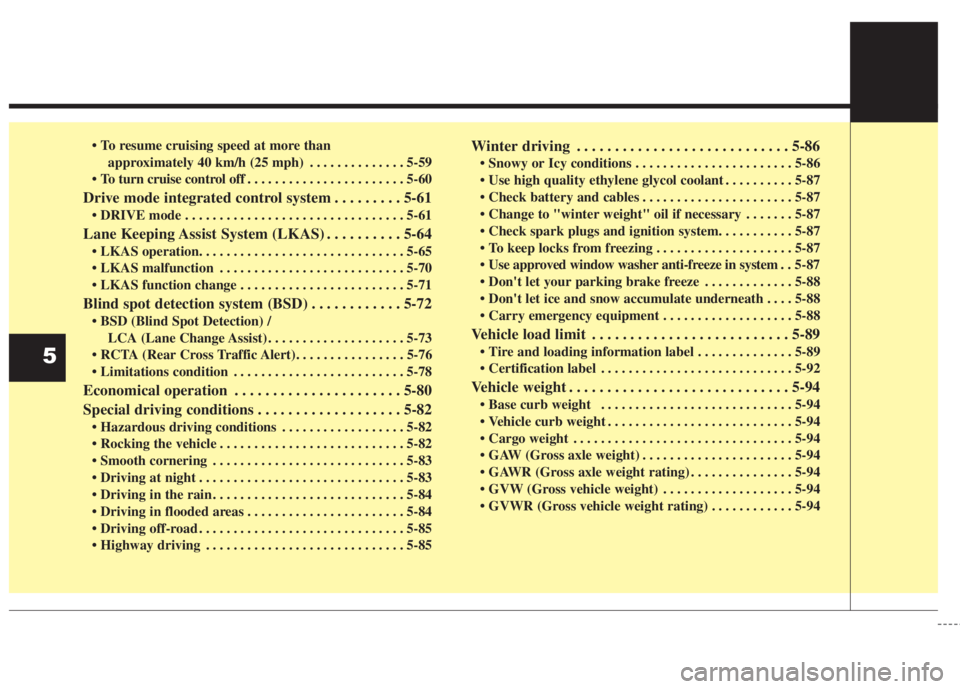
• To resume cruising speed at more than
approximately 40 km/h (25 mph) . . . . . . . . . . . . . . 5-59
• To turn cruise control off . . . . . . . . . . . . . . . . . . . . . . . 5-60
Drive mode integrated control system . . . . . . . . . 5-61
• DRIVE mode . . . . . . . . . . . . . . . . . . . . . . . . . . . . . . . . 5-61
Lane Keeping Assist System (LKAS) . . . . . . . . . . 5-64
• LKAS operation. . . . . . . . . . . . . . . . . . . . . . . . . . . . . . 5-65
• LKAS malfunction . . . . . . . . . . . . . . . . . . . . . . . . . . . 5-70
• LKAS function change . . . . . . . . . . . . . . . . . . . . . . . . 5-71
Blind spot detection system (BSD) . . . . . . . . . . . . 5-72
• BSD (Blind Spot Detection) /
LCA (Lane Change Assist) . . . . . . . . . . . . . . . . . . . . 5-73
• RCTA (Rear Cross Traffic Alert). . . . . . . . . . . . . . . . 5-76
• Limitations condition . . . . . . . . . . . . . . . . . . . . . . . . . 5-78
Economical operation . . . . . . . . . . . . . . . . . . . . . . 5-80
Special driving conditions . . . . . . . . . . . . . . . . . . . 5-82
• Hazardous driving conditions . . . . . . . . . . . . . . . . . . 5-82
• Rocking the vehicle . . . . . . . . . . . . . . . . . . . . . . . . . . . 5-82
• Smooth cornering . . . . . . . . . . . . . . . . . . . . . . . . . . . . 5-83
• Driving at night . . . . . . . . . . . . . . . . . . . . . . . . . . . . . . 5-83
• Driving in the rain . . . . . . . . . . . . . . . . . . . . . . . . . . . . 5-84
• Driving in flooded areas . . . . . . . . . . . . . . . . . . . . . . . 5-84
• Driving off-road . . . . . . . . . . . . . . . . . . . . . . . . . . . . . . 5-85
• Highway driving . . . . . . . . . . . . . . . . . . . . . . . . . . . . . 5-85
Winter driving . . . . . . . . . . . . . . . . . . . . . . . . . . . . 5-86
• Snowy or Icy conditions . . . . . . . . . . . . . . . . . . . . . . . 5-86
• Use high quality ethylene glycol coolant . . . . . . . . . . 5-87
• Check battery and cables . . . . . . . . . . . . . . . . . . . . . . 5-87
• Change to "winter weight" oil if necessary . . . . . . . 5-87
• Check spark plugs and ignition system. . . . . . . . . . . 5-87
• To keep locks from freezing . . . . . . . . . . . . . . . . . . . . 5-87
• Use approved window washer anti-freeze in system . . 5-87
• Don't let your parking brake freeze . . . . . . . . . . . . . 5-88
• Don't let ice and snow accumulate underneath . . . . 5-88
• Carry emergency equipment . . . . . . . . . . . . . . . . . . . 5-88
Vehicle load limit . . . . . . . . . . . . . . . . . . . . . . . . . . 5-89
• Tire and loading information label . . . . . . . . . . . . . . 5-89
• Certification label . . . . . . . . . . . . . . . . . . . . . . . . . . . . 5-92
Vehicle weight . . . . . . . . . . . . . . . . . . . . . . . . . . . . . 5-94
• Base curb weight . . . . . . . . . . . . . . . . . . . . . . . . . . . . 5-94
• Vehicle curb weight . . . . . . . . . . . . . . . . . . . . . . . . . . . 5-94
• Cargo weight . . . . . . . . . . . . . . . . . . . . . . . . . . . . . . . . 5-94
• GAW (Gross axle weight) . . . . . . . . . . . . . . . . . . . . . . 5-94
• GAWR (Gross axle weight rating) . . . . . . . . . . . . . . . 5-94
• GVW (Gross vehicle weight) . . . . . . . . . . . . . . . . . . . 5-94
• GVWR (Gross vehicle weight rating) . . . . . . . . . . . . 5-94
5
Page 347 of 595
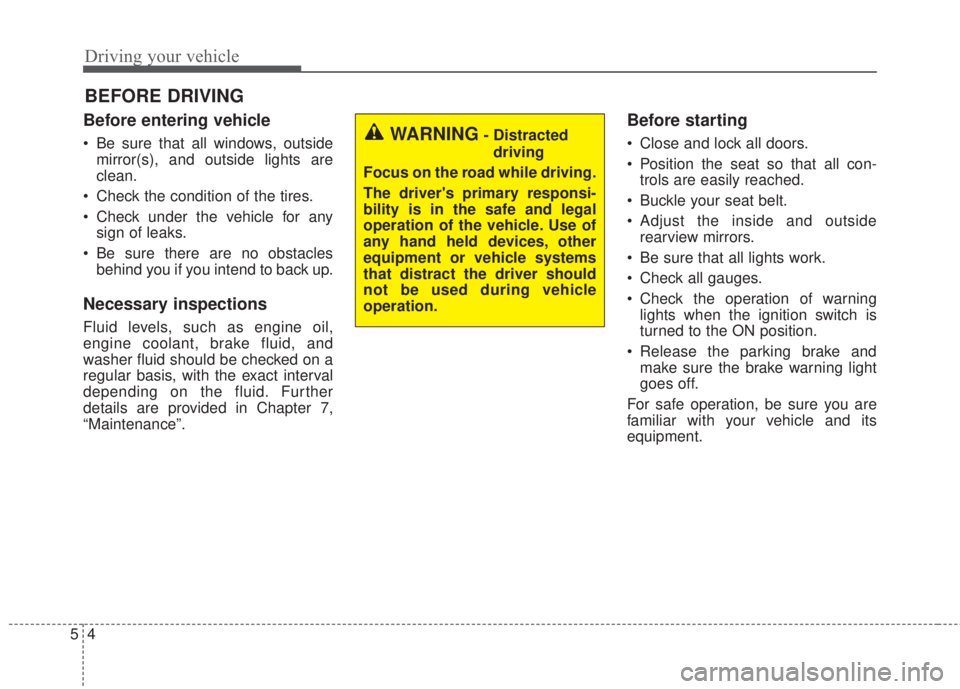
Driving your vehicle
4 5
Before entering vehicle
• Be sure that all windows, outside
mirror(s), and outside lights are
clean.
• Check the condition of the tires.
• Check under the vehicle for any
sign of leaks.
• Be sure there are no obstacles
behind you if you intend to back up.
Necessary inspections
Fluid levels, such as engine oil,
engine coolant, brake fluid, and
washer fluid should be checked on a
regular basis, with the exact interval
depending on the fluid. Further
details are provided in Chapter 7,
“Maintenance”.
Before starting
• Close and lock all doors.
• Position the seat so that all con-
trols are easily reached.
• Buckle your seat belt.
• Adjust the inside and outside
rearview mirrors.
• Be sure that all lights work.
• Check all gauges.
• Check the operation of warning
lights when the ignition switch is
turned to the ON position.
• Release the parking brake and
make sure the brake warning light
goes off.
For safe operation, be sure you are
familiar with your vehicle and its
equipment.
BEFORE DRIVING
WARNING- Distracted
driving
Focus on the road while driving.
The driver's primary responsi-
bility is in the safe and legal
operation of the vehicle. Use of
any hand held devices, other
equipment or vehicle systems
that distract the driver should
not be used during vehicle
operation.
Page 349 of 595
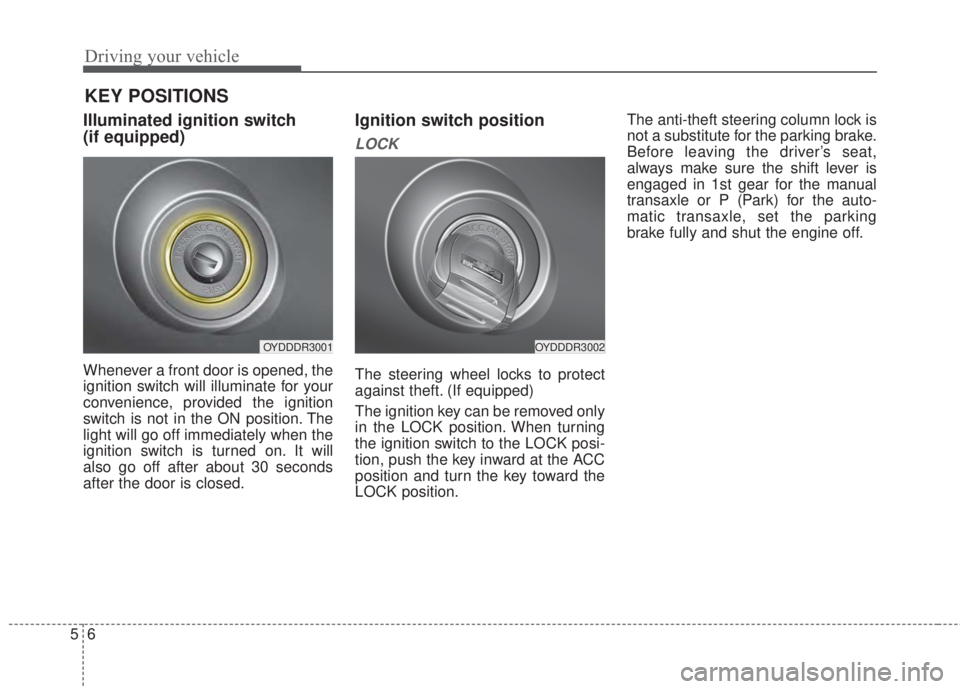
Driving your vehicle
6 5
Illuminated ignition switch
(if equipped)
Whenever a front door is opened, the
ignition switch will illuminate for your
convenience, provided the ignition
switch is not in the ON position. The
light will go off immediately when the
ignition switch is turned on. It will
also go off after about 30 seconds
after the door is closed.
Ignition switch position
LOCK
The steering wheel locks to protect
against theft. (If equipped)
The ignition key can be removed only
in the LOCK position. When turning
the ignition switch to the LOCK posi-
tion, push the key inward at the ACC
position and turn the key toward the
LOCK position.The anti-theft steering column lock is
not a substitute for the parking brake.
Before leaving the driver’s seat,
always make sure the shift lever is
engaged in 1st gear for the manual
transaxle or P (Park) for the auto-
matic transaxle, set the parking
brake fully and shut the engine off.
KEY POSITIONS
OYDDDR3001OYDDDR3002
Page 350 of 595
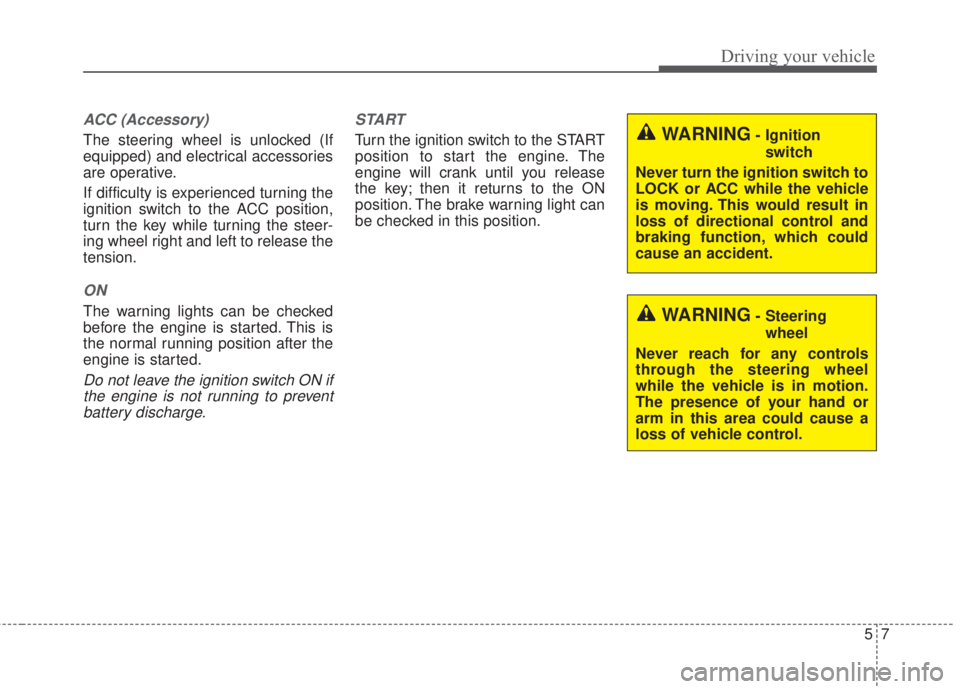
57
Driving your vehicle
ACC (Accessory)
The steering wheel is unlocked (If
equipped) and electrical accessories
are operative.
If difficulty is experienced turning the
ignition switch to the ACC position,
turn the key while turning the steer-
ing wheel right and left to release the
tension.
ON
The warning lights can be checked
before the engine is started. This is
the normal running position after the
engine is started.
Do not leave the ignition switch ON if
the engine is not running to prevent
battery discharge.START
Turn the ignition switch to the START
position to start the engine. The
engine will crank until you release
the key; then it returns to the ON
position. The brake warning light can
be checked in this position.WARNING- Ignition
switch
Never turn the ignition switch to
LOCK or ACC while the vehicle
is moving. This would result in
loss of directional control and
braking function, which could
cause an accident.
WARNING- Steering
wheel
Never reach for any controls
through the steering wheel
while the vehicle is in motion.
The presence of your hand or
arm in this area could cause a
loss of vehicle control.
Page 352 of 595
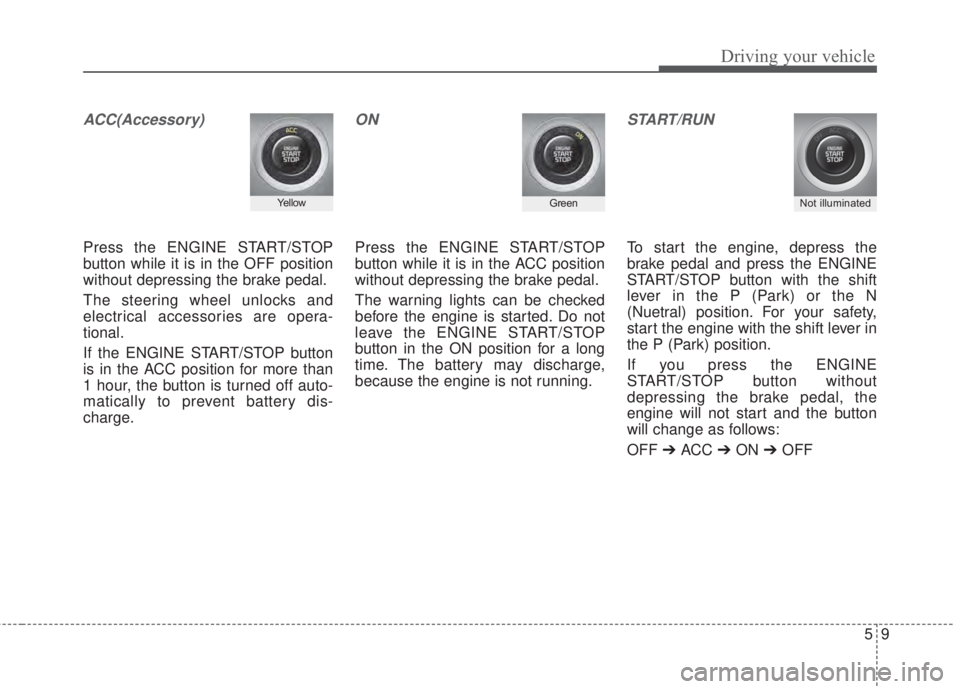
59
Driving your vehicle
ACC(Accessory)
Press the ENGINE START/STOP
button while it is in the OFF position
without depressing the brake pedal.
The steering wheel unlocks and
electrical accessories are opera-
tional.
If the ENGINE START/STOP button
is in the ACC position for more than
1 hour, the button is turned off auto-
matically to prevent battery dis-
charge.
ON
Press the ENGINE START/STOP
button while it is in the ACC position
without depressing the brake pedal.
The warning lights can be checked
before the engine is started. Do not
leave the ENGINE START/STOP
button in the ON position for a long
time. The battery may discharge,
because the engine is not running.
START/RUN
To start the engine, depress the
brake pedal and press the ENGINE
START/STOP button with the shift
lever in the P (Park) or the N
(Nuetral) position. For your safety,
start the engine with the shift lever in
the P (Park) position.
If you press the ENGINE
START/STOP button without
depressing the brake pedal, the
engine will not start and the button
will change as follows:
OFF➔ ACC ➔ON➔OFF
Not illuminated YellowGreen
Page 357 of 595
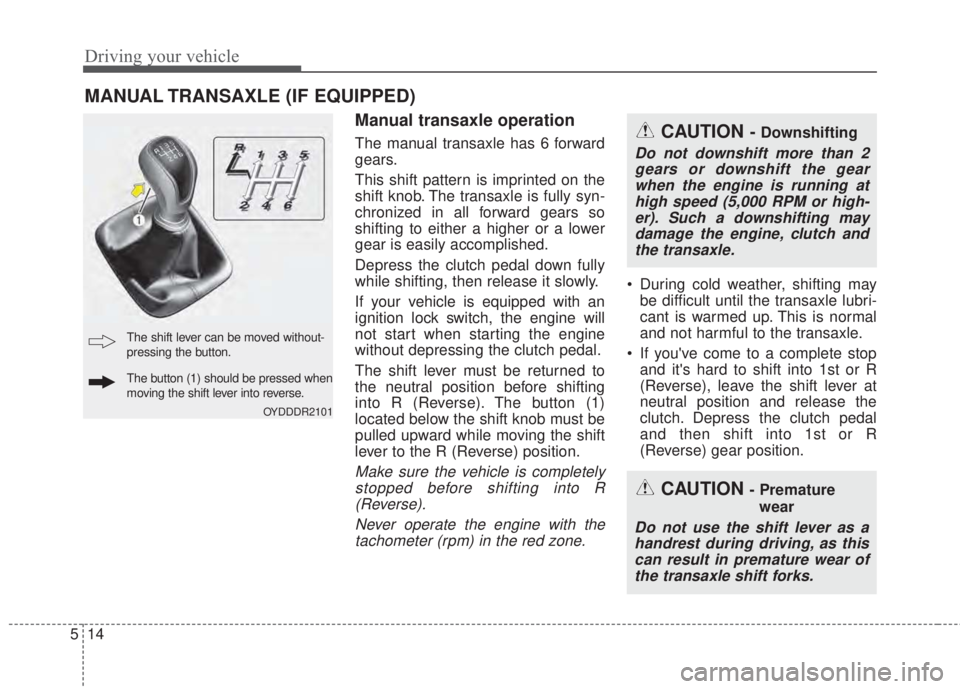
Driving your vehicle
14 5
Manual transaxle operation
The manual transaxle has 6 forward
gears.
This shift pattern is imprinted on the
shift knob. The transaxle is fully syn-
chronized in all forward gears so
shifting to either a higher or a lower
gear is easily accomplished.
Depress the clutch pedal down fully
while shifting, then release it slowly.
If your vehicle is equipped with an
ignition lock switch, the engine will
not start when starting the engine
without depressing the clutch pedal.
The shift lever must be returned to
the neutral position before shifting
into R (Reverse). The button (1)
located below the shift knob must be
pulled upward while moving the shift
lever to the R (Reverse) position.
Make sure the vehicle is completely
stopped before shifting into R
(Reverse).
Never operate the engine with the
tachometer (rpm) in the red zone.
• During cold weather, shifting may
be difficult until the transaxle lubri-
cant is warmed up. This is normal
and not harmful to the transaxle.
• If you've come to a complete stop
and it's hard to shift into 1st or R
(Reverse), leave the shift lever at
neutral position and release the
clutch. Depress the clutch pedal
and then shift into 1st or R
(Reverse) gear position.
MANUAL TRANSAXLE (IF EQUIPPED)
CAUTION -Downshifting
Do not downshift more than 2
gears or downshift the gear
when the engine is running at
high speed (5,000 RPM or high-
er). Such a downshifting may
damage the engine, clutch and
the transaxle.
OYDDDR2101
The shift lever can be moved without-
pressing the button.
The button (1) should be pressed when
moving the shift lever into reverse.
CAUTION - Premature
wear
Do not use the shift lever as a
handrest during driving, as this
can result in premature wear of
the transaxle shift forks.
Page 361 of 595
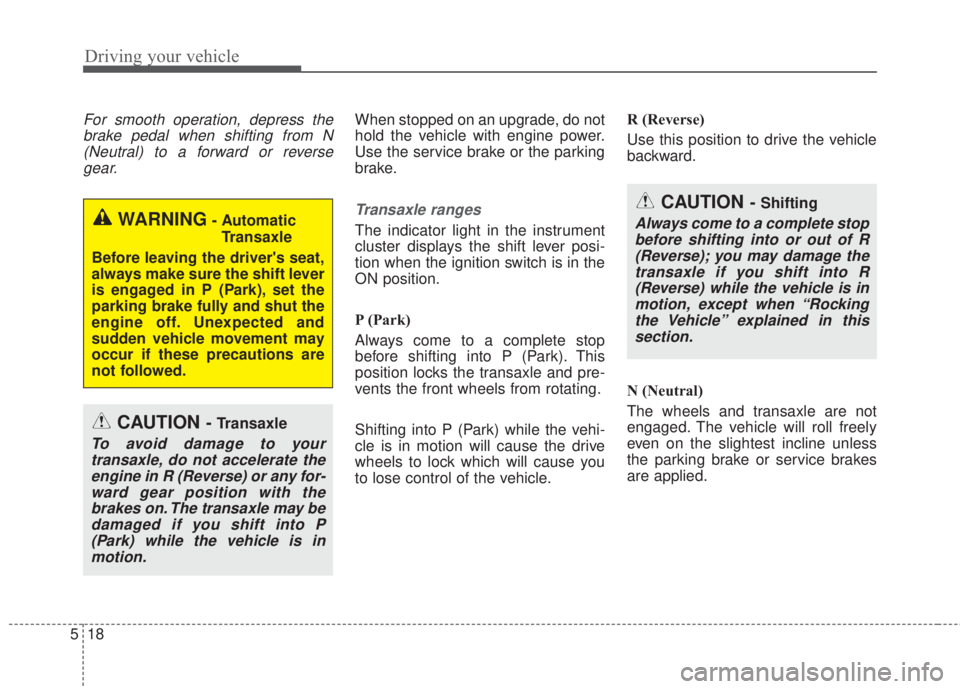
Driving your vehicle
18 5
For smooth operation, depress the
brake pedal when shifting from N
(Neutral) to a forward or reverse
gear.When stopped on an upgrade, do not
hold the vehicle with engine power.
Use the service brake or the parking
brake.
Transaxle ranges
The indicator light in the instrument
cluster displays the shift lever posi-
tion when the ignition switch is in the
ON position.
P (Park)
Always come to a complete stop
before shifting into P (Park). This
position locks the transaxle and pre-
vents the front wheels from rotating.
Shifting into P (Park) while the vehi-
cle is in motion will cause the drive
wheels to lock which will cause you
to lose control of the vehicle.R (Reverse)
Use this position to drive the vehicle
backward.
N (Neutral)
The wheels and transaxle are not
engaged. The vehicle will roll freely
even on the slightest incline unless
the parking brake or service brakes
are applied.
CAUTION -Transaxle
To avoid damage to your
transaxle, do not accelerate the
engine in R (Reverse) or any for-
ward gear position with the
brakes on. The transaxle may be
damaged if you shift into P
(Park) while the vehicle is in
motion.
WARNING- Automatic
Transaxle
Before leaving the driver's seat,
always make sure the shift lever
is engaged in P (Park), set the
parking brake fully and shut the
engine off. Unexpected and
sudden vehicle movement may
occur if these precautions are
not followed.
CAUTION -Shifting
Always come to a complete stop
before shifting into or out of R
(Reverse); you may damage the
transaxle if you shift into R
(Reverse) while the vehicle is in
motion, except when “Rocking
the Vehicle” explained in this
section.
Page 362 of 595
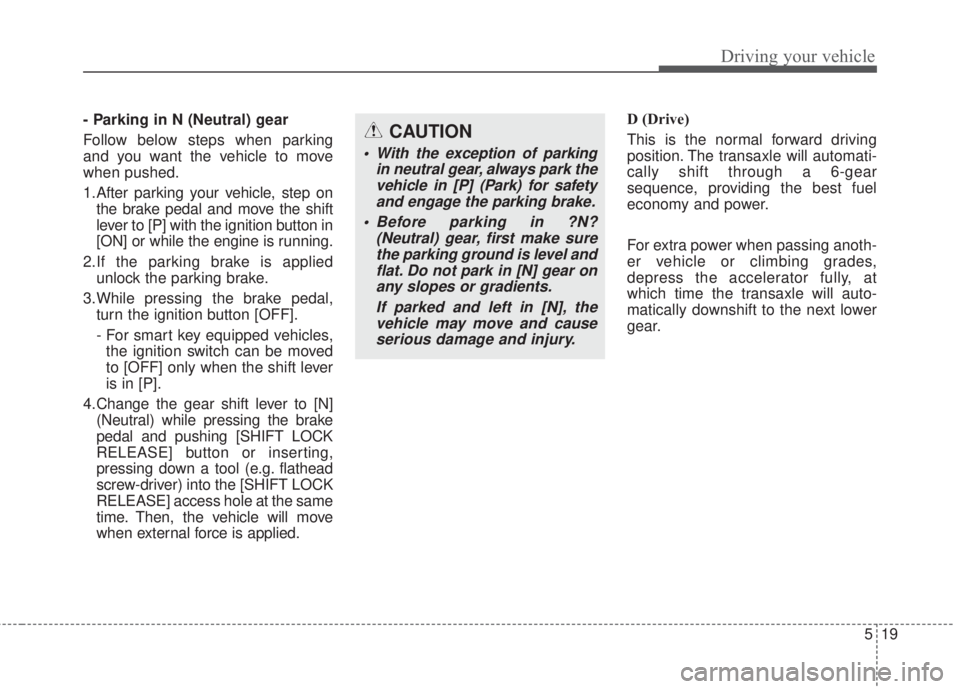
519
Driving your vehicle
- Parking in N (Neutral) gear
Follow below steps when parking
and you want the vehicle to move
when pushed.
1.After parking your vehicle, step on
the brake pedal and move the shift
lever to [P] with the ignition button in
[ON] or while the engine is running.
2.If the parking brake is applied
unlock the parking brake.
3.While pressing the brake pedal,
turn the ignition button [OFF].
- For smart key equipped vehicles,
the ignition switch can be moved
to [OFF] only when the shift lever
is in [P].
4.Change the gear shift lever to [N]
(Neutral) while pressing the brake
pedal and pushing [SHIFT LOCK
RELEASE] button or inserting,
pressing down a tool (e.g. flathead
screw-driver) into the [SHIFT LOCK
RELEASE] access hole at the same
time. Then, the vehicle will move
when external force is applied.D (Drive)
This is the normal forward driving
position. The transaxle will automati-
cally shift through a 6-gear
sequence, providing the best fuel
economy and power.
For extra power when passing anoth-
er vehicle or climbing grades,
depress the accelerator fully, at
which time the transaxle will auto-
matically downshift to the next lower
gear.CAUTION
• With the exception of parking
in neutral gear, always park the
vehicle in [P] (Park) for safety
and engage the parking brake.
• Before parking in ?N?
(Neutral) gear, first make sure
the parking ground is level and
flat. Do not park in [N] gear on
any slopes or gradients.
If parked and left in [N], the
vehicle may move and cause
serious damage and injury.
Page 364 of 595
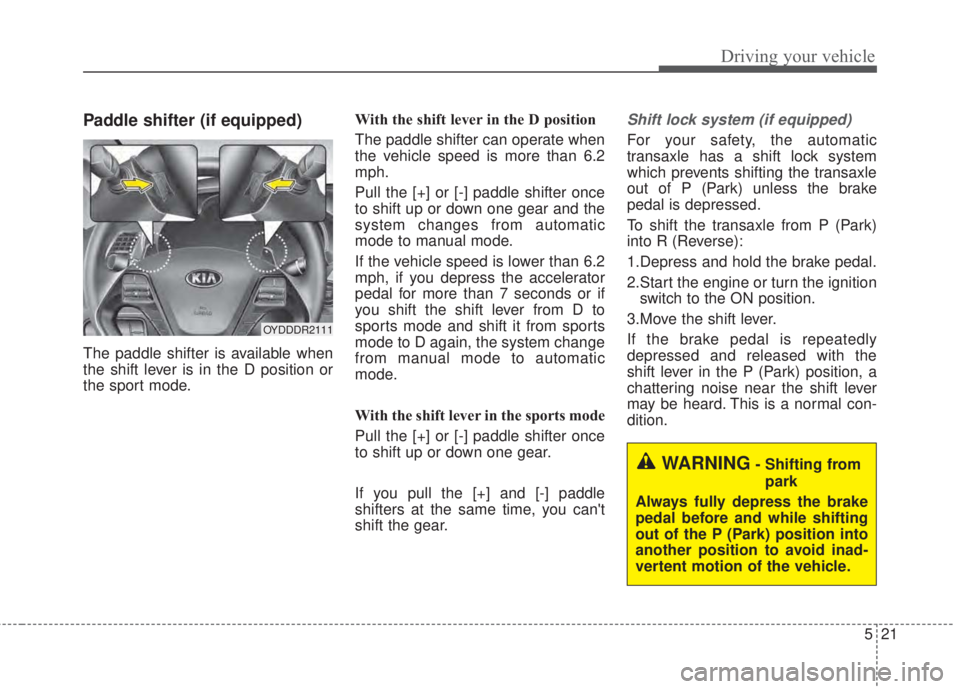
521
Driving your vehicle
Paddle shifter (if equipped)
The paddle shifter is available when
the shift lever is in the D position or
the sport mode.With the shift lever in the D position
The paddle shifter can operate when
the vehicle speed is more than 6.2
mph.
Pull the [+] or [-] paddle shifter once
to shift up or down one gear and the
system changes from automatic
mode to manual mode.
If the vehicle speed is lower than 6.2
mph, if you depress the accelerator
pedal for more than 7 seconds or if
you shift the shift lever from D to
sports mode and shift it from sports
mode to D again, the system change
from manual mode to automatic
mode.
With the shift lever in the sports mode
Pull the [+] or [-] paddle shifter once
to shift up or down one gear.
If you pull the [+] and [-] paddle
shifters at the same time, you can't
shift the gear.
Shift lock system (if equipped)
For your safety, the automatic
transaxle has a shift lock system
which prevents shifting the transaxle
out of P (Park) unless the brake
pedal is depressed.
To shift the transaxle from P (Park)
into R (Reverse):
1.Depress and hold the brake pedal.
2.Start the engine or turn the ignition
switch to the ON position.
3.Move the shift lever.
If the brake pedal is repeatedly
depressed and released with the
shift lever in the P (Park) position, a
chattering noise near the shift lever
may be heard. This is a normal con-
dition.
WARNING- Shifting from
park
Always fully depress the brake
pedal before and while shifting
out of the P (Park) position into
another position to avoid inad-
vertent motion of the vehicle.
OYDDDR2111
Page 365 of 595
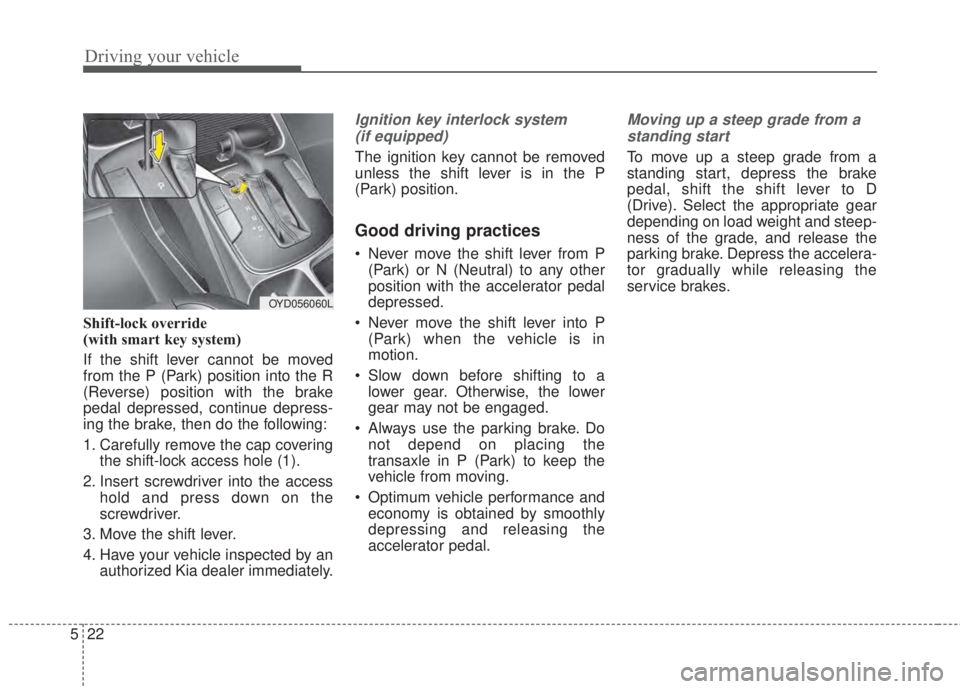
Driving your vehicle
22 5
Shift-lock override
(with smart key system)
If the shift lever cannot be moved
from the P (Park) position into the R
(Reverse) position with the brake
pedal depressed, continue depress-
ing the brake, then do the following:
1. Carefully remove the cap covering
the shift-lock access hole (1).
2. Insert screwdriver into the access
hold and press down on the
screwdriver.
3. Move the shift lever.
4. Have your vehicle inspected by an
authorized Kia dealer immediately.
Ignition key interlock system
(if equipped)
The ignition key cannot be removed
unless the shift lever is in the P
(Park) position.
Good driving practices
• Never move the shift lever from P
(Park) or N (Neutral) to any other
position with the accelerator pedal
depressed.
• Never move the shift lever into P
(Park) when the vehicle is in
motion.
• Slow down before shifting to a
lower gear. Otherwise, the lower
gear may not be engaged.
• Always use the parking brake. Do
not depend on placing the
transaxle in P (Park) to keep the
vehicle from moving.
• Optimum vehicle performance and
economy is obtained by smoothly
depressing and releasing the
accelerator pedal.
Moving up a steep grade from a
standing start
To move up a steep grade from a
standing start, depress the brake
pedal, shift the shift lever to D
(Drive). Select the appropriate gear
depending on load weight and steep-
ness of the grade, and release the
parking brake. Depress the accelera-
tor gradually while releasing the
service brakes.
OYD056060L